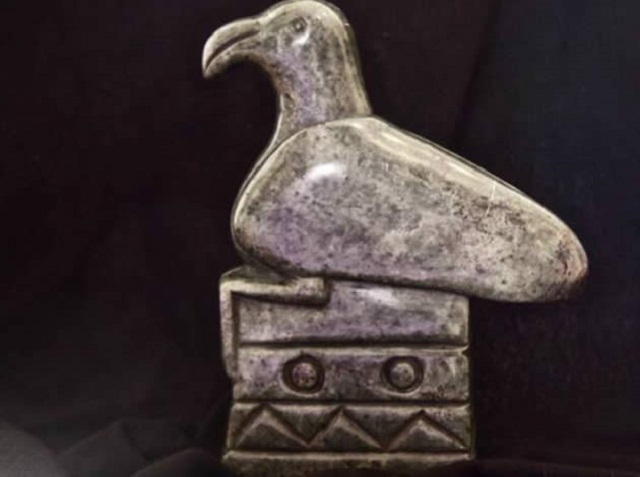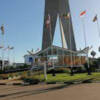
The Sunday News

Pathisa Nyathi
AS we get closer to the Zimbabwe Bird, we need to look at its broader cultural, and more specifically, its cosmological context. The Zimbabwe Bird rests on a pedestal that bears important symbols or icons that require interpretation. As a matter of fact most, if not all, of them have been interpreted in earlier installations.
Interpretation of the icons on the pedestal should provide a thematic context that will resonate with the interpretation of the Zimbabwe Bird and the Great Enclosure and its architecture.
We should never try to isolate the Zimbabwe Bird from its cultural context that represents and expresses the resident theme.
What we have seen so far have been attempts to identify the species of the bird and its significance and role or meaning.
Hardly have there been concerted efforts to dissect the bird and seek the message hidden within its sculpture.
It has been taken for granted that it is a bird, so what remained was to locate it within the understanding and interpretation of the broader cultural edifice.
Who built Great Zimbabwe and for what reason? How we answer that question will inform our interpretation of the Zimbabwe Bird so that there is congruence which obviates conceptual contradictions.
For now, we shall not get ourselves bogged down in the intellectual quagmire of whether the Zimbabwe Bird is a bird or not.
That it has the features of a bird is not in doubt. What the bird represents and expresses is something else
As we often say, the Zimbabwe Bird, like other material phenomena at Great Zimbabwe, is crafted or sculptured in line with the identifiable pervasive theme.
Contradictions are not expected and they do not exist within the Great Enclosure.
Beyond the Zimbabwe Bird, we shall borrow wings from the Zimbabwe Bird so that we see what is on top of the stone walls of the Great Enclosure and see if the pervasive theme is taken up to those levels.
Again, people will see the same objects made from stone or any other material for that matter, but when it comes to representations and expressions, they see totally different things. So it is with the Zimbabwe Bird.
We see the same object which we know to be a bird from our everyday experiences. However, some see beyond the bird, assisted in the process by their creative minds.
We shall argue that the stone-sculpted structures above the stone walls equally denote, represent and express what is already expressed elsewhere within the cultural edifice we call Great Zimbabwe.
We shall further argue that the Zimbabwe Bird is the pinnacle of creative engineering which epitomises in a single structure, what is severally expressed within the Great Enclosure.
Having provided this theoretical background relating to interpretation of phenomena, let’s get to the icons for reiteration and emphasis. We need not belabour the point that the pedestal is not rectangular. Its design is in line with African Architecture.
By and large, the circular design is pervasive within the Great Enclosure elsewhere within the lithic cultural edifice.
This confirms what we have been saying — that there cannot be inconsistency and incongruity. The circular design belongs to some cultures, African cultures in particular and the First Nations in the Americas.
Their basic cosmological thrust is, ‘‘As above, so below.” They seek to replicate the heavens (cosmos/universe) on earth, within the cultural dimension. The African Mind is resident in the architecture of the pedestal.
The icons that we see below the bird are the chevron pattern, circular discs and the crocodile. To some people it may not occur that the three icons represent the same idea or concept.
What we need is to unpack the common denominator among seemingly different icons, central to all of them is the circular disc or just the circle. Africa recognised that a circle has no beginning and no end.
It thus represents and expresses the concepts of continuity, endlessness, eternity, immortality and perpetuity. The next step is to get to the chevron pattern and relate it to a circle.
The first step is to reduce the chevron pattern to a chevron motif/ icon which is a single upward facing open “V.”
What we are calling a “V” is true only when we refer to a two dimensional plane. In reality, the “V” which is inspired by the body of woman, is a cone.
A cone is circular, comprising an infinite number of circles of diminishing lengths of radii if one starts from the top.
If one chooses to start from the bottom, then the radii are increasing in length. A woman, unlike a two dimensional surface, is three dimensional: length, width and height.
The “V” is that part of woman that embraces the womb, the most critical component within the reproductive system. In animals such as human beings, the womb is the site where concepts of continuity, eternity, endlessness, perpetuity and immortality are concretised.
What we are saying, in essence, is that through sexuality the said concepts are realised. Imagine a chevron pattern comprising several “Vs,” each actually a womb, you will get a better picture of what we are referring to.
Going beyond this, we should appreciate that sexual reproduction is what lies at the centre of continuity of the human species (individuals perish, humanity is forever), and yet there are two critically important elements that must come together, male and female represented by male and female sexual organs.
If you keep this in mind and appreciate the role of artistic enterprise in negotiating the socially obscene and vulgar terrain, you will see how the Zimbabwe Bird comes into play.
Instead of sculpting male and female genitals in action, the sacrosanct baby-manufacturing act was artistically engineered in such a manner that the average person sees a bird fully sanitised of vulgarity in African moral terms.
To get to the chevron pattern beyond the single “V”, we need to get to the principles of African Aesthetics. One of them is repetition.
We cannot begin to talk about repetition where there is movement. In this case, it is movement that is characterised by regularity or, to use another term, rhythm or periodicity which render predictability.
Again, the idea of repetition is embodied in African Sculpture, African Architecture nay, in all African artistic renditions such as music and dance.
Poetic renditions are no exceptions. It is this regular, seasonal, rhythmic and periodic repetition that imparts beauty to a chevron pattern. It also bears balance, symmetry and equilibrium.
What should be emerging from the above discourse is the centrality of the idea of fertility which sexuality brings to the fore.
Centering fertility is the womb which, by the way is circular — see it when it is extended by the growing embryo within it.
It never assumes a rectangular shape. Last week, Professors Herbert Moyo and Timothy from the Universities of KwaZulu-Natal and Drake in the USA respectively, and I were driving to the Njelele Rain Shrine, I gazed at the dome-shaped hill and began, on the basis of its shape, to see a womb; extended in readiness to deliver life, a baby.
Njelele Hill is said to have some water within the cave in its interior. That adds to the fertility dimension of the womb with its amniotic fluid.
Mother Earth gets pregnant, through being fertilised during the symbolic wosana dances. After creation of the rain ambience and symbolic manipulation of rain, from gathering clouds to falling rain, the heavens open up.
Finally, the crocodile is perceived and understood as comprising chevron motifs. Remember the “leg of a frog” that the Venda people see in the crocodile. I have called reptiles in general and the crocodile in particular, chevron animals.
This is because of their “V”s or differently expressed, their “wombs’. In other words, a crocodile has chevron motifs and chevron patterns. It is an animal that best symbolises the womb which is the site where continuity and eternity are effected.
Hopefully, it has become apparent that the crocodile, the chevron pattern and the circular discs all translate to one thing — the circle, the womb and fertility.




